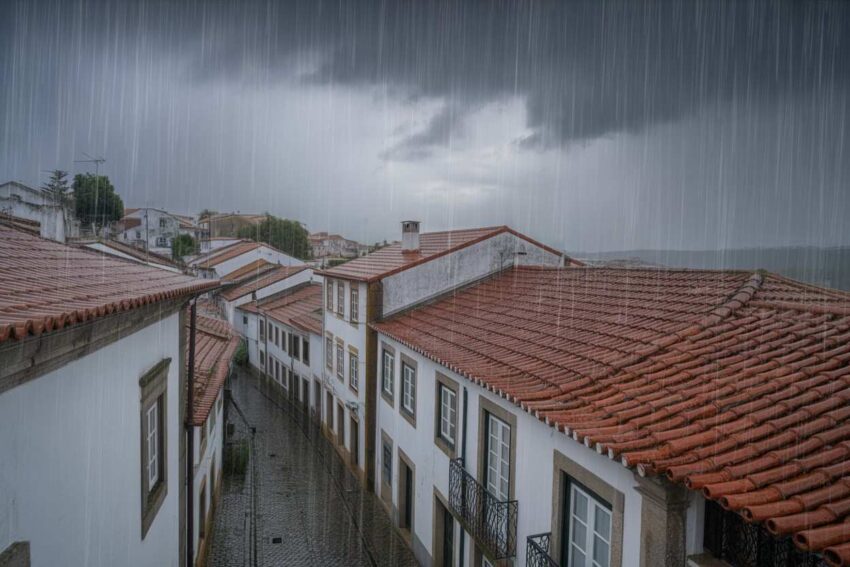Portugal Under Orange Alert as Extreme Rainfall Hits Nine Districts Across Mainland: All You Need to Know

The Portuguese Institute of the Sea and the Atmosphere (IPMA) has issued a high-level orange weather alert, the second most severe warning, for nine districts in northern and central mainland Portugal, urging both residents and travelers to take extra precaution due to forecast heavy and persistent rainfall. The affected districts under this orange alert as of today include Bragança, Viseu, Porto, Guarda, Vila Real, Viana do Castelo, Aveiro, Coimbra, and Braga, with the IPMA warning that these regions could experience localized flooding, travel disruption, and rapidly changing conditions through the day.
The orange alert was issued by the IPMA following an initial yellow alert, reflecting an escalation in risk level due to the latest meteorological data. According to the IPMA, the rainfall in these areas is expected to be intense and sustained, potentially impacting outdoor activities, road safety, and local tourism operations across northern and central Portugal.
Orange Alert: What It Means for Travelers and the Public
An orange weather alert is the second-most serious level on the Portuguese warning system, indicating a meteorological situation with moderate to high risk for the population. The IPMA uses this alert when there are real possibilities of impacts to urban mobility, river levels, and overall public safety. Severe weather conditions such as heavy rainfall, strong winds, and the potential for flash floods are common triggers for this warning status.
Travelers in or heading to affected districts, especially those in Porto, Braga, and Coimbra, should monitor official weather updates, limit non-essential travel, and follow instructions from local civil protection authorities. Flood-prone areas, riverside paths, and low-lying roads should be avoided, as rapid water level increases are possible.
Impact on Tourism and Local Activities
The extreme weather warnings come as Portugal continues to experience increased visitation, with the northern and central regions, including cities like Porto, Braga, Coimbra, and Aveiro, remaining popular among domestic and international tourists. However, under orange alert conditions, outdoor activities such as sightseeing, hiking, wine region tours, and coastal excursions may need to be postponed or canceled.
Porto’s historic riverside attractions, Braga’s famed sanctuaries, and Coimbra’s university district could see lower visitor turnout as tourism operators and hospitality businesses adjust schedules in response to adverse weather forecasts. Travelers should consult hotel and tour operators in advance for rebooking options or to confirm any changes to plans.
Those renting vehicles or navigating rural roads are advised to exercise extra caution, as wet conditions and potential flooding may cause sudden road closures or hazardous driving conditions.
Regional Authorities Mobilize for Safety
Local civil protection agencies in each affected district have heightened their alert level, placing emergency services on standby for rapid response to any incidents. The IPMA is working closely with municipal governments and emergency responders to provide real-time updates and early warning notifications as conditions evolve.
Residents and visitors should also be aware of the potential for brief power outages, public transportation delays, and possible interruptions to regional train and bus services.
Recent Weather Patterns and Climate Context
Portugal has experienced more frequent severe weather episodes in recent years, often linked to broader climate variability and shifts in Atlantic storm patterns. The current heavy rainfall is part of a wider meteorological trend affecting the Iberian Peninsula, with a series of Atlantic low-pressure systems expected to bring additional precipitation over the coming days.
The presence of persistent, sometimes torrential rain can heighten the risk of landslides in mountainous areas such as those surrounding Viseu, Vila Real, and Guarda. The IPMA has also reiterated that the saturation of soils in these regions increases the likelihood of flash flooding and rapid runoff, especially in valleys and urban centers close to rivers.
Guidance for Travelers and Tourism Businesses
Travelers planning to visit or transit through the affected districts during the orange alert period are strongly encouraged to:
- Check real-time weather updates via the IPMA official portal
- Confirm reservations and activities with local hotels, guides, and tour companies
- Avoid riverbanks, coastal cliffs, and hiking trails during active rainfall or storms
- Stay informed about road closures and public transportation changes
- Heed all local civil protection advisories and act promptly if instructed to relocate or seek shelter
Tourism service providers and event organizers in Porto, Braga, Aveiro, and other highlighted districts are urged to maintain open communication with guests, staff, and authorities, helping to ensure traveler safety while minimizing disruption to itineraries where possible.
Outlook and Recovery
According to the IPMA, the rainfall is expected to gradually ease as the latest Atlantic weather system moves out of the region, but further showers and unsettled weather remain in the near-term forecast. Travelers and residents should remain alert for additional updates and be prepared for quick adjustments as needed.
The post Portugal Under Orange Alert as Extreme Rainfall Hits Nine Districts Across Mainland: All You Need to Know appeared first on Travel And Tour World.